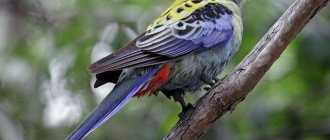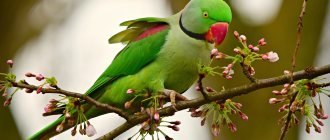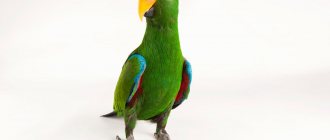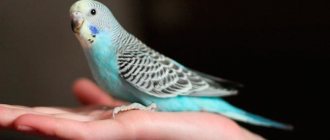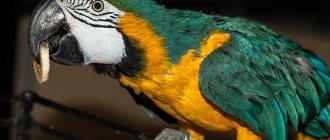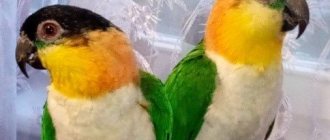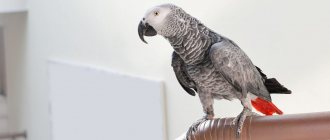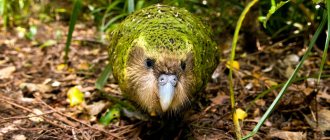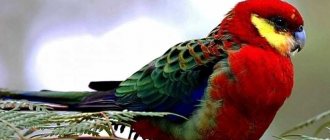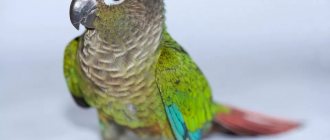General characteristics of the noble bird
In ornithological reference books the species is referred to as Eclectus roratus - the noble green-red parrot. The first mention of it dates back to 1776. The bird is quite large: about 40 cm in length and weighs almost half a kilo . The plumage is thick with a texture somewhat reminiscent of silk. The tail is short and rectangular.
The beak is massive, curved and very strong. With its help, the parrot calmly cracks nuts and other solid food. The iris with a yellowish tint is barely noticeable on the plumage. Eclectus paws are large, dark gray in color with black claws. Individuals of different sexes are radically different from each other.
In some scientific works, this species is classified as a subfamily of Psittaculini (true parrots). But according to recent ornithological research, the Eclectus parrot has much more in common with Loriinae.
Photo of eclectus:
Males
In mature individuals, bright green plumage predominates: the torso, head and part of the flight wings. The axillary zone is painted red, and individual areas have blue, yellow, blue and black inserts. The upper part of the beak of males is orange, and the lower part is dark gray.
Females
The color of the female is rich and bright. The main color is cherry: head, smaller part of the breast, wings. The abdomen, together with the axillary area, has a dark blue tint. The tips of the flight wings and individual tail feathers are yellow and purple. The beak is completely black without any color transitions like the male.
It is also useful to read: Congo parrot
Varieties of Eclectus
Scientists managed to find out that Eclectus is not the only species of its genus Eclectus. On the islands of Vanuatu, Fiji and Tonga, the remains of Eclectus infectus, which was distinguished by its smaller wings, were discovered. Birds disappeared more than 3 thousand years ago - after people settled in their territory. Later, the existing species of Eclectus (Eclectus roratus) was divided into 9 subspecies, depending on external features and habitat. Although for a long time this classification was not considered final, because scientists were unable to penetrate into some regions where parrots live (difficult geographical location, political nuances).
| Subspecies | Peculiarities | Habitat |
| 1.E.r. roratus | They began to mate with the dominant Vosmaeri parrots, so every year their color becomes more and more similar to the dominant. | Buru, Seram, Ambone, Saparua, Haruku, Maluku. |
| 2.E.r. Vosmaeri | Large, with a more yellow tint to the plumage. | Maluku |
| 3.E.r. Aruensis | The rich yellow color at the tip of the male's tail is often mixed with pink, orange or bright red. | Aru |
| 4.E.r. Biaki | Has minor differences in color and behavior. | Biak |
| 5.E.r. Cornelia | Males are large, with pale green feathers, while females are completely red. | Sumba |
| 6.E.r. Riedeli | Males have green-blue cheeks and a yellow border on the tail, while females have inclusions of blue with a yellow border along the edge of the tail against the background of red feathers. | Tanimbar |
| 7.E.r. Polychloros | Rich green color at the base of the color. | New Guinea, Kay, West Papua, D'Entrecasteaux, Louisiade, Gorham. |
| 8.E.r. Macgillivrayi | They resemble Polychloros, but are larger. | Cape York |
| 9.E.r. Solomonensis | Similar to Polychloros, but smaller in size; with a small beak. | Solomon Islands |
In 2021, they decided to divide eclectus parrots into four main subspecies:
- Moluccan (E. Roratus, including Vosmaeri);
- Papuan (E. Polychloros, including Aruensis, Biaki, Acgillivrayi and Solomonensis);
- Sumba (Eclectus cornelia);
- Tanimbar (Eclectus riedeli).
Ornithologists doubt this section because of Aruensis and Biaki, and the question of their affiliation remains open.
Subspecies E. r. vosmaeri is the most popular among breeders. Recently he was also joined by E. r. Macgillivrayi, which also began to win the hearts of lovers of exotic fauna.
How do they live in the wild?
The main bird population is concentrated in Australia. The parrot can also be found on the islands of eastern Indonesia and New Guinea. Due to their high numbers, they are often classified as pests . As soon as the young animals begin to live separately from their parents, eclectuses cause a lot of problems for farmers, destroying crops.
Birds prefer to inhabit dense forests. They do not build their own nests, but settle in the hollows of large trees at an altitude of 20 to 50 meters from the ground. Parrots roam in small groups of 10-15 individuals. But they don’t live together: each couple looks for a separate hollow.
Nutrition
This variety of parrots are vegetarians, but not gourmets. In nature, eclectus feed on flowers, their nectar, young leaves and buds, and can eat fresh soft bark from shoots.
Of course, parrots' diet includes fruits, including their seeds and cores, berries, and small nuts. The bird will also happily eat the grains. They love eclectus and berries. These parrots walk quite easily and a lot, both along the branches of the tree in the hollow of which they live, and on the ground next to it.
This type of parrot never catches insects, preferring to stand or “sit” and look at butterflies rather than chase them. Moreover, if a bird’s hollow is affected by wood borers or any other pests, the eclectus simply abandons it and looks for something new.
Character traits
Eclectus is a calm and balanced bird. She can sit on a perch for a long time and in complete silence, fiddling with some toy.
Parrots avoid turmoil and do not like change. If the cage or accessories are constantly moved, the bird will begin to experience stress.
Some consider eclectus to be boring, dull and stupid animals. Actually this is not true. Many ornithologists agree that representatives of this species are much smarter than the same Gray Gray or Macaw.
They just perceive this world differently - more balanced and calm. This is where the second name of the bird came from - the noble parrot.
Eclectus is not the best solution for families with children. The latter want activity from their pets: games, singing, lots of tricks, and so on. But the calm nature of the bird cannot give this. The ideal owner for eclectus is a single person or a couple without children.
Parrots have a friendly disposition. They quickly become attached to their owner and appreciate his attention. If a pet is kept in an aviary with other birds, then conflicts may arise due to jealousy, although eclectus is more lenient towards representatives of its own species.
The parrot learns relatively quickly, mastering both conversational skills and some simple tricks. Males are more likely to exercise than females. In addition, the latter usually behave a little more aggressively. But with a competent approach to education and training, females will become affectionate and loving pets.
Can they live at home?
The bird is well adapted to life in captivity. Eclectus cannot be called picky in terms of content. They take care of themselves on their own; they do not need premium food with any exotic additives or a specific cage.
The only critical condition is temperature. The bird does not tolerate cold very well. She will begin to freeze, and at the same time catch a cold, as soon as the thermometer drops below +20°C. Therefore, it is better for residents of the northern regions of Russia to look towards more hardy pets.
It is permissible to keep two males or sexual partners in one cage. But a pair of females will never coexist in the same territory, which should be taken into account when choosing a parrot.
How to organize the life of parrots at home
First of all, you should take care of the two most important things - cage and nutrition. Both should already be prepared before purchasing a pet. Even if temporary housing in a box and food of dubious quality will ruin both the psyche and health of the animal.
Arrangement of the cage
The place for the parrot should be equipped taking into account its dimensions. Eclectus is a large bird and solutions for small animals will not suit it. The optimal option for one mature individual is 90 x 60 x 80 cm (LxWxH). If you plan to keep a couple, then the area should be increased by at least one and a half times.
It is more advisable to look for a cage made of durable and non-toxic material. The ideal option is an all-metal solution with powder coating. Buying a cage made of wood is impractical, because the parrot will simply chew through the material with its large and strong beak. In addition, such solutions, when in contact with water, become a breeding ground for harmful bacteria.
You cannot buy a cage made of cheap plastic. The latter emits toxic fumes, especially in the warm season, which is fraught with poisoning and related diseases, and sometimes the death of the pet. The same goes for inventory.
Accessories required for a parrot:
- feeder;
- drinking bowl;
- perches/perches;
- swimsuit;
- toys.
Equipment should also be selected taking into account the size of the bird. A parrot will not perceive a feeder and drinker that are too small as such. The swimsuit must be proportionate. Solutions for budgies, for example, will not meet the needs of the pet. Extremes are also unacceptable. In an overly large container, a parrot may choke, given the propensity of eclectus to swim.
The perches needed are different, both in purpose and in shape. The bird should have a bar for cleaning its beak and paws, as well as a perch. Pet stores have specialized options for both the first and second. It is more practical to use concrete solutions for cleaning beaks and claws, while they are not suitable for perches because they do not retain heat well. The ideal option here would be wooden poles of irregular shape.
Crossbars for large birds must match the grip of the paws. If the diameter is smaller, the limbs will begin to develop incorrectly. It is extremely difficult to correct defects of this kind.
As for toys, it all depends on the owner. If the bird is kept alone, then they are necessary in any case. Toys brighten up the pangs of loneliness when the owner is not at home. Otherwise, the pet begins to stress, falling into apathy. When keeping a pair as such, there is no need for toys, because the birds entertain themselves.
Popular toys for large birds:
- mirrors;
- stairs;
- balls;
- bells;
- trolleys;
- rings.
On sale you can find gaming complexes that already have a certain set of accessories. They can be attached to the cage or installed independently of it. It is better to look towards modular solutions, which can later expand the playing area or, on the contrary, remove unnecessary things.
Nutrition
In the wild, eclectus feed on berries, grains and fruits. In captivity they should be given similar conditions. Dry food, even at a premium level, does not provide the vitamins and minerals necessary for the bird’s body. In addition to grain, your pet needs fruits and vegetables. Also, there should always be fresh water in the drinking bowl.
Products useful for eclectus:
grain mixture;- carrot;
- peas;
- tomato;
- eggplant;
- peach;
- apple;
- banana;
- plum;
- raisin.
To replenish minerals, it would be useful to install a sepia or mineral stone in the cage. You can buy them at any pet store.
You should not give your parrot avocado or chocolate. Porridges and other mixtures should be prepared without salt and sugar. Birds obtain glucose and minerals through fruits and vegetables. In their pure form, they can cause serious harm to the gastrointestinal tract.
Games, communication, conversation training
Eclectus, like other domesticated birds, requires attention from the owner. If he is not ready to set aside at least an hour a day for games and communication, then it is better not to get a pet. Eclectus cannot be called playful, but teaching them simple tricks is quite possible.
They can carry balls, push carts, etc. Making them somersault through a hoop or select elements based on color and shape like cockatoos, alas, is not an easy task. As for the imitation of human speech, Eclectus is doing just fine with this. They are far from being a Gray, who can learn about 400 words, but mastering 40-60 phrases is quite possible for him.
Training takes place in the usual format for parrots. It is enough to repeat the desired phrase 10-15 times without using other words. After a day or two, the bird will begin to imitate what was said. The main thing is not to burden your pet with a lot of phrases.
It is better to learn them gradually, assigning each word to some action. For example, before serving food - “Kesha wants to eat”, during games - “Kesha is dancing/jumping/singing”, etc. Thus, the parrot will call household members by name, address them, ask for something or express dissatisfaction.
Differences in domestication of males and females
Eclectus males are trusting by nature and almost immediately make contact with humans. Whereas females are more careful: to win their favor, you will have to spend much more effort. The main thing here is not to rush.
Training a female should start with getting used to her hands. If she does not avoid the person and does not rush into the cage at the sight of him, then you can start training. Training should take place at the same time. This way the parrot will get ready to work.
The learning process will be noticeably more productive if the pet receives a favorite treat for each correct action. It is impossible to force a bird to learn, so if it lacks the desire, you should postpone attempts until next time.
Is it possible to breed parrots at home?
Ornithologists and professional breeders strongly do not recommend breeding chicks of this species in apartments. The bird needs appropriate conditions, one of which is an aviary. An eclectus is not a budgerigar and just a cage with a nesting house inside is not enough.
Due to the lack of free space, the female will experience severe stress at the time of laying, or will completely refuse to hatch eggs. During this period, the male must be kept as far as possible from his partner, because she becomes extremely aggressive. And in a cage, a dangerous neighborhood is inevitable.
It is also useful to read: Passerine parrot
Owner reviews
Reviews about Eclectus are mostly positive. The bird is not distinguished by its restless disposition, loudness or pickiness about food. A balanced character and ability to learn make a pet attractive to purchase. The parrot does not have any critical disadvantages.
Advantages of Eclectus according to owner reviews:
- friendly disposition;
- suitable for allergy sufferers;
- fast learner;
- unpretentious in food;
- doesn't scream in the morning.
Minuses:
- has great difficulty adapting to a new place and to a different owner;
- cleans the cage daily, scattering debris;
- does not get along well with other birds.
Diseases and prevention measures
There are a number of health problems that are most common with eclectus. Thus, these birds are quite shy, have difficulty adapting to everything new and may suffer from stressful molting or self-plucking.
In the absence of external stimuli, remaining alone for a long time, the pet will sleep, eat little, move and may also get sick.
For an unknown reason, this species of birds experiences spasms in the muscles of the legs or wings. Such birds need to adjust their diet, add more vitamins and minerals to the diet, for example, greens, twig food, and special fertilizers.
Eclectus also suffer from other pathologies found in other birds. These include infectious, parasitic and fungal diseases. Most can be avoided by keeping the cage clean, promptly changing food and drink, and maintaining quarantine when purchasing a new bird.
The litter should be re-placed daily. The cage and its contents should be washed at least once a week. And every three months, thoroughly disinfect equipment.
All About Pets: Eclectus Parrots
